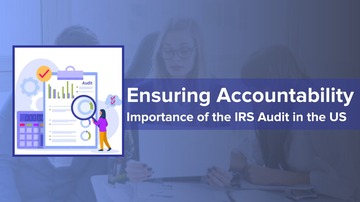
What is an IRS Audit?
An IRS Audit is a systematic and independent examination of an organization’s books or individual’s accounts, statutory records, documents, and vouchers to ascertain how far the financial statements and non-financial disclosures present a true and fair view of the concern. It also ensures that the organization complies with applicable laws and regulations. Audits can be conducted internally by employees of the organization or externally by an outside firm. The IRS also conduct audit to ensure that every taxpayers and organizations are reporting their income correctly.
Introduction
The Internal Revenue Service is a federal Government of the United States that is responsible for collecting federal taxes. Its mission is to provide taxpayers of America with top-quality services by helping them understand and meet their tax responsibilities and to enforce the law with integrity and fairness to all. The Internal Revenue Service handles corporate, gift, excise, and estate taxes as well, which also include mutual funds and dividends. Nearly 90% of tax returns are filed every year with the Internal Revenue Service (IRS), which makes it an important agency for maintaining tax regulations and IRS tax audit in the United States.
Four Stages of an Audit Cycle
Planning—Audit preparations consist of planning everything by interested parties such as the auditor, lead auditor, client, and the audit program manager to ensure that the audit complies with the client’s objective. This stage of an audit begins with the decision to conduct the audit and ends when the audit itself begins.
Execution– The next phase of an audit is called execution or fieldwork. It is the data-gathering portion of the audit and covers the period from arrival at the audit location up to the exit meeting. It consists of multiple activities, including on-site audit management, meeting with the auditee, understanding the process and system controls, verifying that these controls work, communicating among team members, and communicating with the auditee.
Reporting– The purpose of the audit report is to communicate the results of the investigation. The report should provide correct and clear data that will be effective as a management aid in addressing important organizational issues. The audit process may end when the report is issued by the lead auditor or after follow-up actions are completed.
Follow-up and Closure- The audit is completed when all the planned audit activities have been carried out or otherwise agreed with the audit client. The verification of follow-up actions is a part of subsequent audits.
Key audits in the United States include:
IRS Audits
The IRS tax Audit examines tax returns to verify that the tax is correct. The majority of taxpayers file returns and make payments timely and accurately. They have the right to expect fair tax administration from the IRS. The agency randomly selects taxpayers to audit or single out those whose returns are related to others audited. While there is no single factor that determines who gets an IRS tax audit each year, there are some red flags that may trigger a review:
· Failing to declare the right amount of income
· Claiming a higher-than-normal number of deductions.
· Claiming rental real estate losses
The IRS audit process begins with an auditor reviewing the return. The auditor may either accept the return or request a further review by an examination group. In the latter case, the taxpayer is notified by mail. The audit involves reviewing paperwork and may be conducted by mail or in person at an IRS office or another location, such as the taxpayer’s home, business, or accountant’s office. The audit process has four phases, each one requiring the involvement of our audit clients. During planning, they work with you to understand and learn about your area so that they can evaluate the processes and controls currently in place. Fieldwork consists of specific testing scenarios or steps to identify areas for improvement. The results are communicated through a transparent reporting process. Finally, follow-up is when they come back to you after a determined period to reassess the progress made against the agreed-upon management action plans.
What happens after the IRS Audit?
If you receive an audit notice, consider consulting a tax professional who can guide you through the process and help represent you during any IRS investigation. You will need to gather all relevant paperwork, such as receipts, bank statements, and any records that support the information on your audit tax return. Keep thorough records of your finances, including receipts and documents that support your tax claims. This will make the audit tax return process smoother. If you believe the audit results are incorrect, you can request an IRS investigation or appeal the decision. It’s crucial to respond promptly and maintain open communication with the IRS. With the right understanding and approach, you can handle any IRS investigation that comes your way and ensure your financial records are in order for years to come.
EEOC Audit
An EEOC audit, also known as an Equal Employment Opportunity Commission audit, is a review process conducted to ensure that an organization complies with federal laws prohibiting discrimination in the workplace. Here are some key aspects of an EEOC audit:
Purpose
To verify that an organization’s employment practices are free from discrimination based on race, color, religion, sex (including pregnancy, gender identity, and sexual orientation), national origin, age (40 or older), disability, or genetic information.
Scope
- The audit may review hiring practices, promotions, terminations, pay equity, and other employment policies and practices.
- It often involves an examination of the organization’s EEO-1 Report, which provides a demographic breakdown of the workforce.
Process
- The EEOC may request documentation, such as employee handbooks, training materials, personnel files, and records of complaints and investigations.
- Interviews with employees and management may be conducted to gather additional insights.
Outcome
If non-compliance or discriminatory practices are found, the EEOC may recommend corrective actions, such as policy changes, training programs, or other measures to address the issues. In severe cases, legal action may be taken against the organisation.
Benefits
- Ensures compliance with federal anti-discrimination laws.
- Helps identify and rectify potential discriminatory practices within the organisation.
- Promotes a diverse and inclusive workplace culture.
Overall, an EEOC audit helps organizations maintain fair and equitable employment practices, reducing the risk of discrimination claims and fostering a more inclusive work environment.
ICE Audit
The administrative inspection process is initiated with the service of a Notice of Inspection (NOI) upon an employer. Employers receive at least three business days to produce the Form I-9 requested in the NOI. Currently, employers who physically examine the documentation presented by new employees may choose to make and retain copies or scans of the documentation presented by employees to complete the Form I-9. However, employers that use E-Verify must make and retain copies of documentation presented by employees for List A of Form I-9. Lastly, qualified employers who use an alternative procedure with an employee must retain a clear and legible copy of all documents presented by the employee seeking to establish identity and employment eligibility for Form I-9. When an employer responds to an NOI by producing Form(s) I-9, auditors inspect the Form I-9 for compliance. When they find technical or procedural failures, the employer receives at least 10 business days to make corrections. An employer may receive a monetary fine for all substantive violations and uncorrected technical or procedural failures. Employers who are found to have knowingly hired or continued to employ unauthorized workers will be required to cease the unlawful activity and may be civilly fined and may be subjected to suspension or debarment by the auditor.
Workplace Audit
A safety audit under OSHA is a process that evaluates the health and safety of a work setting. During an audit, a group gathers data about a location’s operations. They identify hazards and illustrate how to make the area safer for employees. Organizational leaders use audits to develop safety procedures for their team members. Audits of work sites are conducted for the purpose of health, safety, and fire hazard identification. During these surveys, assessments are made for compliance to applicable building and fire codes and the detection of unsafe hazards. Worksite audits also provide an evaluation of compliance with Occupational Safety and Health Administration (OSHA) standards. A safety audit involves a rigorous observation of business operations, the work environment, the condition of equipment, the behavior of the workers, and other details to ensure that you have a good workplace safety plan in place and that it is being implemented according to industry safety standards. Monetary penalties and fines are the most common consequences of non-compliance. In extreme cases (often related to unsafe working conditions or violating environmental rules) your business could be forced to shut down some, or all, of its operations.
Conclusion
Audits play a crucial role in maintaining the integrity, transparency, and efficiency of organizations in the United States. By systematically examining various aspects of operations, from financial statements to compliance with laws and regulations, audits help ensure that organizations adhere to best practices and regulatory requirements. In conclusion, audits are indispensable tools for organizational governance and accountability in the U.S. They help organizations uphold high standards, comply with regulations, and continuously improve their operations. By embracing the audit process, organizations can build a strong foundation for long-term success and stakeholder confidence.




